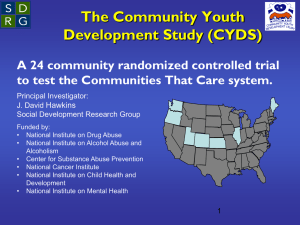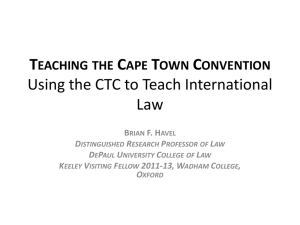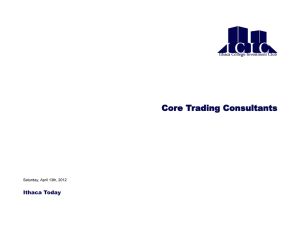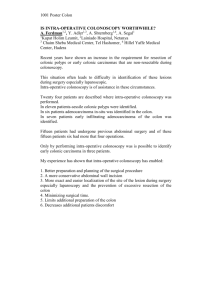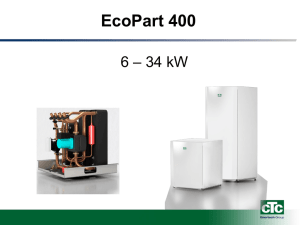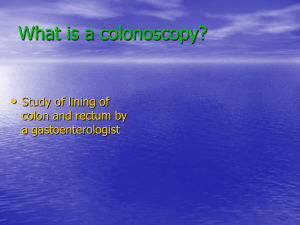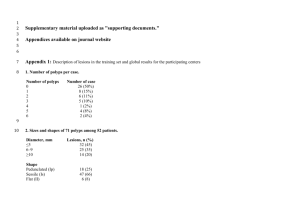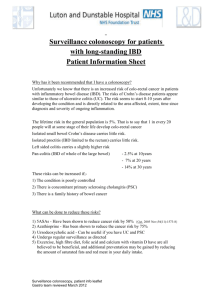THE NATIONAL CT COLONOGRAPHY TRIAL
advertisement
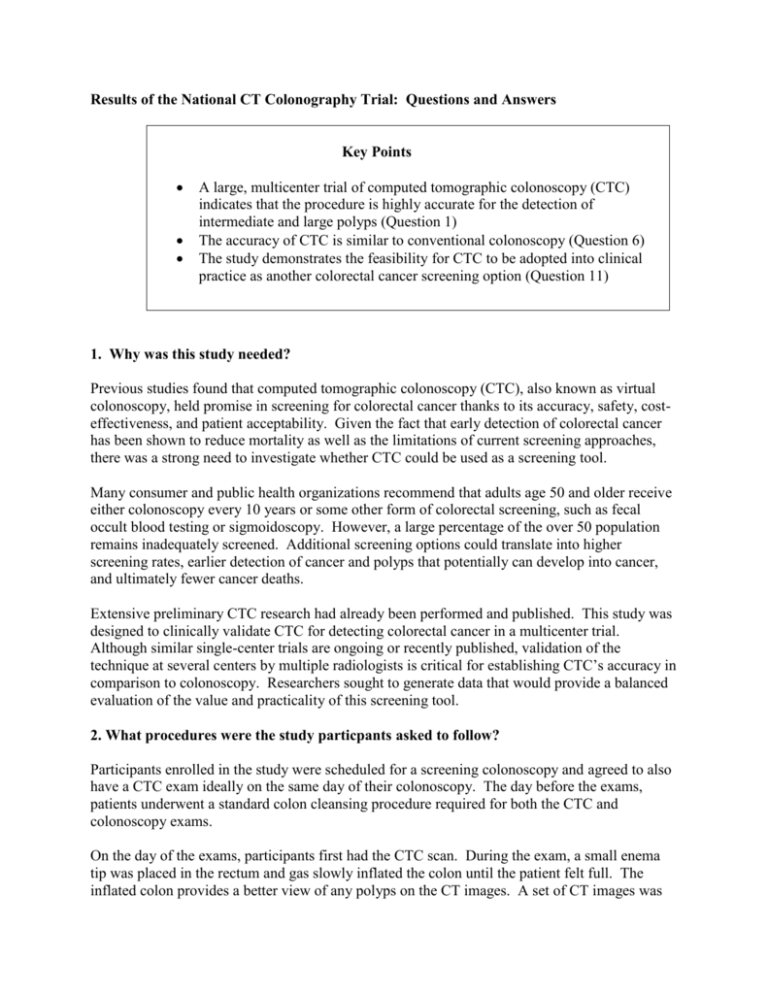
Results of the National CT Colonography Trial: Questions and Answers Key Points A large, multicenter trial of computed tomographic colonoscopy (CTC) indicates that the procedure is highly accurate for the detection of intermediate and large polyps (Question 1) The accuracy of CTC is similar to conventional colonoscopy (Question 6) The study demonstrates the feasibility for CTC to be adopted into clinical practice as another colorectal cancer screening option (Question 11) 1. Why was this study needed? Previous studies found that computed tomographic colonoscopy (CTC), also known as virtual colonoscopy, held promise in screening for colorectal cancer thanks to its accuracy, safety, costeffectiveness, and patient acceptability. Given the fact that early detection of colorectal cancer has been shown to reduce mortality as well as the limitations of current screening approaches, there was a strong need to investigate whether CTC could be used as a screening tool. Many consumer and public health organizations recommend that adults age 50 and older receive either colonoscopy every 10 years or some other form of colorectal screening, such as fecal occult blood testing or sigmoidoscopy. However, a large percentage of the over 50 population remains inadequately screened. Additional screening options could translate into higher screening rates, earlier detection of cancer and polyps that potentially can develop into cancer, and ultimately fewer cancer deaths. Extensive preliminary CTC research had already been performed and published. This study was designed to clinically validate CTC for detecting colorectal cancer in a multicenter trial. Although similar single-center trials are ongoing or recently published, validation of the technique at several centers by multiple radiologists is critical for establishing CTC’s accuracy in comparison to colonoscopy. Researchers sought to generate data that would provide a balanced evaluation of the value and practicality of this screening tool. 2. What procedures were the study particpants asked to follow? Participants enrolled in the study were scheduled for a screening colonoscopy and agreed to also have a CTC exam ideally on the same day of their colonoscopy. The day before the exams, patients underwent a standard colon cleansing procedure required for both the CTC and colonoscopy exams. On the day of the exams, participants first had the CTC scan. During the exam, a small enema tip was placed in the rectum and gas slowly inflated the colon until the patient felt full. The inflated colon provides a better view of any polyps on the CT images. A set of CT images was produced with the patient lying on their back and stomach—holding their breath for a brief moment in each position. No sedation was required. The images were then sent to a computer for review by a radiologist. Following the CTC exam, the colonoscopy was performed according to the standard procedures at each participating site. The colonoscopy was performed without the physician having knowledge of the CTC results. The CTC and colonoscopy reports were compared after both procedures were complete. Participants were advised to have a repeat colonoscopy within 90 days if a polyp one centimeter or larger was detected on the CTC exam and not identified during colonoscopy. Two weeks after their exams, participants were sent a questionnaire about their screening experience. 4. Who were the participants? Over 2,600 participants were enrolled in the study at 15 institutions across the United States. They were both men and women age 50 years or older who were scheduled for screening colonoscopy and did not have symptoms of colorectal disease. The researchers excluded patients with serious medical conditions that would increase the risk associated with colonoscopy, or people who had had colonoscopies within the past five years. 5. Who conducted the study? This study was conducted by the American College of Radiology Imaging Network (ACRIN), a cooperative cancer research group supported and funded by the National Cancer Institute (NCI). The trial principal investigator was C. Daniel Johnson, M.D., from the Mayo Clinic in Scottsdale, Ariz. Statistical and study methods were overseen by Mei-Hsiu Chen, Ph.D., a statistician within the ACRIN Biostatistics Center at Brown University’s Center for Statistical Sciences in Providence, R.I. The radiologists at each of the 15 participating sites served as the site principal investigator and had to have either interpreted 500 CTC exams or participate in a specialized CTC training session. In addition, all radiologists were required to pass a pre-study qualifying examination. 6. What did the study find about CTC as a cancer screening tool? This large, multicenter trial indicates that CTC is highly accurate for the detection of intermediate and large polyps. The study found that CTC detected 90 percent of polyps one centimeter or larger. Even polyps as small as a half centimeter in width were detected with high sensitivity (78 percent or greater, depending on the size of the polyp). The accuracy of CTC was found to be similar to conventional colonoscopy. If polyps of a significant size are found during CTC, patients must also undergo subsequent conventional colonoscopy. This study suggests that for detecting large polyps this will be the case for fewer than 10 percent of all participants; most patients will be spared the cost, risk, and inconvenience of having subsequent colonoscopy. For patients who will require follow-up colonoscopy, the researchers recommend referring physicians, endoscopists and radiologists work together to provide same-day examinations to eliminate the need for a second colon cleansing. 7. Why are polyps the size of one centimeter or larger especially important to detect? Generally, polyps of this size are more likely to develop into cancer. However, smaller polyps can also be cancerous and this study demonstrated that CTC is able to detect even smaller polyps with high sensitivity. Sensitivity in this study was defined as the number of polyps detected by CTC that were later confirmed by biopsy as actually being polyps that have the potential to become cancerous. Specific sensitivities were: 78 percent for polyps 6mm in size or greater 84 percent for polyps 7mm in size or greater 87 percent for polyps 8 mm in size or greater 90 percent for polyps 9 mm in size or greater 8. How much radiation is a patient exposed to during a CTC exam? The amount of radiation exposure during a single CTC exam is very small and is reported to be 50 percent less than the standard CT scan of the abdomen or pelvis. The radiation exposure from one CTC exam is approximately equivalent to the exposure one experiences from our natural surroundings in 20 months. This amount of radiation exposure is similar to that of a barium enema, an already accepted colorectal cancer screening exam. 9. What types of CT scanners were used in this study? Sites were required to use a 16-slice (or higher) CT scanner that can obtain 16 slices (or images) per x-ray tube rotation. These types of CT scanners can acquire thinner slices for better image quality. Scanners used in this study include those manufactured by: General Electric (Milwaukee, Wis.) Siemens (Munich, Germany) Philips (Best, Noord-Brabant, Netherlands) Toshiba (Tochigi, Japan) 10. Where were the 15 study sites located? Beth Israel Deaconess Medical Center, Boston Clinical Radiologists, S.C., Memorial Medical Center, Springfield, Ill. Johns Hopkins University, Baltimore Mallinckrodt Institute of Radiology, St. Louis Mayo Clinic, Scottsdale, Ariz. Mayo Clinic, Rochester, Minn. MD Anderson Comprehensive Cancer Center, Houston Radiology Imaging Associates, Englewood, Colo. San Francisco Veterans Administration Medical Center, San Francisco Scottsdale Medical Imaging, Ltd., Scottsdale, Ariz. UCLA School of Medicine, Los Angeles UCSD Medical Center, San Diego University of Chicago Hospital, Chicago Virginia Commonwealth University Medical Center, Richmond, Va. Yale University and VA Connecticut Healthcare System, West Haven, Conn. 11. Is it likely that these study results could be repeated? Yes, it is likely that the study results can be widely reproduced in a community setting if the study procedures are duplicated. A radiologist’s competence to perform and interpret CTC exams is dependent upon adequate CTC training which includes review of case material and familiarity with appropriate software. The radiologists participating in the study were required to pass a certifying examination on the interpretation of CTC images. The researchers suggest radiologic and other professional organizations work together to offer continuing education for radiologists to gain the competence to perform and accurately interpret CTC examinations. Also, establishment and certification of quality and competency standards would help ensure that the training is translated to the clinical environment. 12. What other information will we learn from this study? This study will also inform researchers about: The effect of differing colon preparations The willingness of patients to repeat CTC vs. colonoscopy Detection of hard-to-find flat lesions Differences in software and reader preferences Cost effectiveness relative to other colorectal screening tests ###
